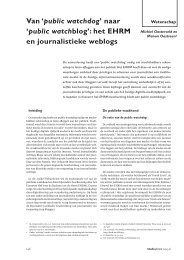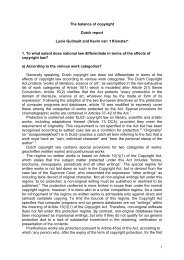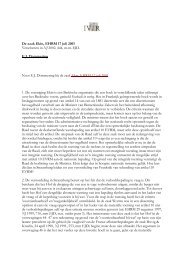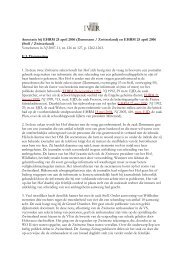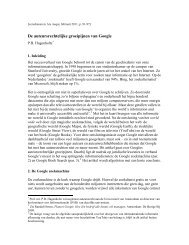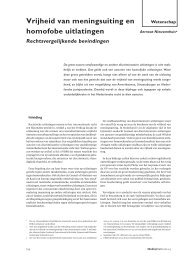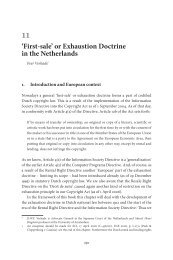ADAPTING COPYRIGHT TO THE INFORMATION ... - IViR
ADAPTING COPYRIGHT TO THE INFORMATION ... - IViR
ADAPTING COPYRIGHT TO THE INFORMATION ... - IViR
Create successful ePaper yourself
Turn your PDF publications into a flip-book with our unique Google optimized e-Paper software.
<strong>ADAPTING</strong> <strong>COPYRIGHT</strong> <strong>TO</strong> <strong>THE</strong> <strong>INFORMATION</strong> SUPERHIGHWAY<br />
P. Bernt Hugenholtz *<br />
1. Towards the Information Superhighway<br />
`... within the foreseeable future we will have computer systems in which<br />
thousands or even millions of authors' works - books, articles, pictorial works,<br />
maps, music, plays, recordings, motion pictures, and other forms of artistic<br />
expression - are permanently stored in a single copy. These computer systems<br />
will be linked, by wire or laser beams or communications satellites or some other<br />
method, with other computers throughout the world. These in turn will be linked<br />
with viewing screens in public institutions and in private homes and businesses.<br />
Any work from this great body of authorship could instantly be inspected by<br />
anyone in reach of a viewing screen, and that person could obtain a copy of any<br />
or all of the works merely by pressing buttons. In many cases the demand and<br />
need for printed copies will completely disappear'. 1<br />
More than 25 years have passed since Barbara Ringer predicted the advent of the digital<br />
networked environment and the profound impact this would have on the law of<br />
copyright. In 1996 much of Barbara Ringer's prediction has materialized. Today, more<br />
than 25 million computer owners are linked on a global scale by the Internet, the<br />
forerunner of the information superhighway. Internet users all over the world have direct<br />
access to vast quantities of text, data, maps, photographs, computer games, still and<br />
moving images, and sound recordings. Spectacular advances in network fidelity, data<br />
compression and storage capacity will enable the Internet (or any other computerized<br />
telecommunication network) to eventually carry nearly the complete Berne Convention<br />
catalogue of works. Moreover, the digital environment will enable traditionally distinct<br />
categories of works to merge into new breeds of works containing information in a<br />
plurality of `modes', so-called multimedia works.<br />
Indeed, the advent of the information superhighway has not taken the copyright<br />
community entirely by surprise. The copyright problems of computerized information<br />
storage and retrieval systems have been studied ever since the early 1970's. 2 Problems<br />
relating to the dissemination of copyrighted works through cable networks are equally<br />
* Associate Professor, Institute for Information Law, University of Amsterdam; advocate, Stibbe Simont<br />
Monahan Duhot, Amsterdam. This paper is based on studies prepared for the European Commission<br />
(DG XIII and DG XV) in 1994 and 1995.<br />
1 B. Ringer, `The Use of Copyrighted Works in Information Storage and Retrieval Systems', German<br />
translation in: GRUR Int 1968, 18.<br />
2 See e.g. E. Ulmer, Elektronische Datenbanken und Urheberrecht, Munich, 1971; D. Goose, Die<br />
urheberrechtliche Beurteilung von elektronischen und Mikrofilm-Datenbanken, Berlin, 1975; P.B.<br />
Hugenholtz, Auteursrecht en information retrieval. Verveelvoudiging en openbaarmaking in het<br />
computertijdperk, Deventer, 1982; P. Katzenberger, `Urheberrechtsfragen der elektronischen<br />
Textkommunikation', GRUR Int 1983, 895; F. Gotzen, `Grandes orientations du droit d'auteur dans les<br />
états-membres de la C.E.E. en matière de banques de données', in: Banques de données et droit<br />
d'auteur, Paris, 1987, 85; A. Lucas, Le droit de l'informatique, Paris, 1987, 289; Les nouveaux moyens<br />
de reproduction, XXXVII Travaux de l'Association Henri Capitant, Journées néerlandaises, Paris,<br />
1988; M. Vivant (ed.), Lamy droit de l'informatique, nos. 1563-1617.
well researched. Moreover, `multimedia' works have been in existence, albeit in a<br />
somewhat primitive form, for many years; video games and moving pictures are wellknown<br />
examples of `multimedia' works avant la lettre.<br />
So, one might conclude, we have seen it all before: the arrival of the information<br />
superhighway is an evolutionary, not a revolutionary development. The existing<br />
copyright system has proven to be flexible enough in the past. There is no need for<br />
radical changes in the future; never change a winning team.<br />
Arguably, this down-to-earth approach would make a sensible and pragmatic short-term<br />
solution. If the European Software Directive 3 has proven anything, it is that legislators<br />
should not overreact to the problems presented by new information technologies. In the<br />
long run, however, this conservative approach will probably not suffice. The<br />
development of the information superhighway is, admittedly, a gradual process. But the<br />
combined effects of mass digitalization, networking on a global scale, and information<br />
delivery on demand, will eventually require more than just piece-meal changes to the<br />
present copyright system. The emerging digital networked environment is affecting the<br />
very economic underpinnings of the present copyright system. In the end, a thorough<br />
rethinking of the copyright paradigm will be probably be inevitable. 4<br />
No such exercise will be undertaken in this paper. Its main purpose is to suggest short<br />
term solutions, primarily from a European perspective, to some of the most pressing<br />
copyright problems of the digital networked environment. The focus of this paper, then,<br />
will be on the scope and limitations of the existing catalogue of protected rights (§§ 2-4).<br />
How do the various acts of network communication (digitization, uploading,<br />
transmission, browsing, viewing, downloading) fit in into the current system? Is there an<br />
imminent need for redefinition or clarification of the exploitation rights? Will existing<br />
copyright exemptions survive in the new environment? Does the good-old `old media'<br />
exhaustion rule come into play?<br />
Prior to these discussions, I will make some general observations on the nature of the<br />
`information superhighway', as it affects - or may affect - the law of copyright, both in<br />
theory and practice.<br />
1.1 The information superhighway<br />
In this paper, the `(information) superhighway' shall be short-hand for the digital<br />
networked environment of the near future. The superhighway is neither a new product,<br />
nor a new service, nor a new type of network. It represents the integrated, broad-band,<br />
high-speed, general-purpose telecommunications network of the coming century. The<br />
superhighway will not be a single physical network, but a conglomerate of local,<br />
regional, national and transnational telecommunications infrastructures, interlinked to<br />
form a global information superhighway.<br />
From a technical perspective, the superhighway is not homogenous. The necessary<br />
physical links will be provided by copper wires, optical fibres, radio links and satellites,<br />
3 Directive of the Council of the European Communities of 17 May 1991, O.J.EC L 122/42.<br />
4 See Egbert J. Dommering, `Copyright being washed away through the electronic sieve', elsewhere in<br />
this volume.
or a combination thereof. In the superhighway a variety of existing telecommunications<br />
infrastructures, such as the telephone network, cable networks, satellite networks and<br />
broadcasting stations will converge. The infrastructure of the superhighway will not be<br />
operated by a single, monopolistic telecommunications operator. It will not be a<br />
monolithic network; parts of it will be controlled by operators under a state monopoly,<br />
other parts by private companies. Users and information providers will probably not deal<br />
with these network operators directly; access and service providers will provide the<br />
necessary telecommunications services and facilities.<br />
The superhighway will be a broad-band network, permitting the communication of data,<br />
text, audio, video and images at high speed and high fidelity. As an integrated `network<br />
of existing networks', the superhighway will carry both digital and analogue signals. In<br />
contrast to most existing cable networks, the superhighway will permit interactive, twoway<br />
communication. Information can be uploaded and downloaded to and from any<br />
point in the network; consumers will be able to receive information on individual<br />
demand. Conversely, information users may become information providers as well.<br />
Will tomorrow's superhighway be the Internet of today? Perhaps. Clearly, many of the<br />
criteria in the above-mentioned definition presently apply to the Internet. However, the<br />
Internet's limited bandwidth does not, as yet, make full scale audio and video services<br />
(either broadcast or on-demand) a realistic option. These technical limits<br />
notwithstanding, most of the copyright problems discussed in this paper exist - and<br />
require urgent solution - in the context of the Internet as well.<br />
1.2 Convergence<br />
The emerging superhighway and the multimedia programs it will carry, exemplify the<br />
general trend towards convergence in the telecommunications and information industry.<br />
This tendency can be perceived on different levels.<br />
Convergence of `platforms'<br />
In analogue times, different modes of communications required dedicated `platforms'.<br />
For switched voice telecommunications (POTS: `plain old telephone service'), narrowband<br />
networks were used, which were traditionally operated by state-controlled PTTs.<br />
Radio and television programs were disseminated over hertzian waves or, in a later stage<br />
of development, via broad-band cable networks. Similarly, for various forms of off-line<br />
communications genre-specific media were employed. Printed paper carried text or<br />
photo's, vinyl records carried sound, celluloid film carried moving pictures.<br />
In the emerging digital environment, the medium is gradually being `liberated' from the<br />
message. PTT-operated telephone networks will soon carry full-motion video programs.<br />
Cable networks will provide interactive programming and person-to-person voice and<br />
data communications. Compact discs will carry motion pictures and all sorts of<br />
interactive multimedia programs. Traditional print media are giving way to electronic<br />
delivery systems as the preferred platform for disseminating text and data.<br />
This convergence of `platforms' directly affects the structure of the present copyright<br />
system. In the digital environment the existing borderlines between the different genres<br />
of works are becoming blurred and hard to maintain. This is problematic, since the
present copyright system does not protect each genre equally; in most European<br />
countries, e.g., a computer program is better protected than, say, a novel 5 . Moreover, in<br />
many countries the rightholder's exploitation rights are defined in platform or genre<br />
specific terms: right of printing, right of broadcasting, right of cable distribution, etc.<br />
Convergence of roles<br />
As the Internet experience clearly demonstrates, traditional actors in the communications<br />
process (information producer, provider, publisher, intermediary and user) will take on<br />
new roles in the digital networked environment. The Internet is structured as an `open<br />
platform model', as opposed to the `broadcasting model' of most existing mass media. On<br />
the Internet authors may freely disseminate their works without the intervention of<br />
traditional publishers: authors are becoming `publishers'. Moreover, digital technology<br />
enables users to actively search and manipulate information available on the network:<br />
users are becoming authors. Furthermore, traditional intermediaries, such as university<br />
libraries, may take on new roles as information providers: intermediaries are becoming<br />
publishers as well. This convergence of roles may eventually affect the existing system<br />
of rights allocation in copyright and neighbouring rights legislation.<br />
1.3 Communicating on the superhighway: a change of paradigms?<br />
The digital networked environment of the superhighway represents a change of<br />
paradigms for the traditional copyright industries. Mass circulation of copies carrying<br />
identical information products is replaced by transmission of customized information on<br />
demand. In this process, the `public sphere' between information provider and<br />
information user is gradually dissolving. 6 The act of `publishing' thereby loses much of<br />
its original connotation. The increasingly `private' nature of information distribution on<br />
the superhighway is amplified by the increasing use of encryption techniques.<br />
Information on demand<br />
The superhighway infrastructure enables users to actively communicate with information<br />
providers: interactivity. Users can retrieve information of their choice from information<br />
banks at innumerable points on the network. Conversely, publishers and other<br />
information providers will `customize' information to accommodate specific user<br />
demands, employing detailed `user profiles' drawn up from previous usage patterns. In<br />
this process of interactive and customized information usage, the information product<br />
will gradually lose its `concrete' form of expression. Instead, the product will merely<br />
serve as a source file for an infinite variety of derivative information products on<br />
demand.<br />
Interactivity and customization combined will make existing (or future) legal distinctions<br />
between `stand-alone' and collective works (such as audiovisual works and databases)<br />
difficult to maintain. On the superhighway, the collective work will rarely be consumed<br />
5 Pursuant to the European Software Directive, supra note 3, most copyright exemptions that apply to<br />
ordinary `writings', e.g. for private copying, are not valid in respect of computer programs.<br />
6 Th. Dreier, `Copyright digitized: philosophical impacts and practical implications for information<br />
exchange in digital networks', paper presented at WIPO Worldwide Symposium on the Impact of<br />
Digital Technology on Copyright and Neighbouring Rights, Harvard University, 31 March - 2 April<br />
1993, p. 11-14.
in its entirety. Instead, the interactive user will use only the most useful (customized)<br />
`bits and pieces' - the `nuggets' of the treasure trove. For this reason alone, creating a<br />
separate `multimedia' work category would be ill advised.<br />
It is expected delivery on demand will gradually replace `broadcasting' (the simulcasting<br />
of information to a passive audience) as the principal communication pattern of the<br />
superhighway. In the future, unlike today's Internet, proprietary information will<br />
probably no longer `roam around freely over the net'. 7<br />
Metering<br />
The intelligence built into the superhighway will enable information providers to<br />
precisely monitor and control the individual user's information consumption. Whereas in<br />
the present world of physical copies, royalties are calculated on a per-copy basis, on the<br />
superhighway royalties can - and will - be charged per actual use. A per-use (`pay-asyou-go')<br />
royalty scheme may be either time-based or volume-based; of course, flat rate<br />
schemes are possible as well.<br />
Direct licensing<br />
Many rightholders believe (or wish to believe) that the built-in intelligence of the<br />
superhighway will enable them to grant and administrate licenses to individual users<br />
themselves. Works disseminated over the superhighway will carry identifying `tags',<br />
inviting prospective users to (automatically) contact right owners, or `permission<br />
headers', pre-determined licensing conditions to which users may agree in real time. 8<br />
`Self-administration of rights' might gradually replace collective licensing or collective<br />
administration of rights. Thus, the digital networked would bring back to rightholders<br />
what they (nearly) lost in the age of mass copying: the power to transact directly with<br />
information users.<br />
Encryption<br />
Encryption of information-carrying signals is already customary in some branches of the<br />
information industry: satellite-to-cable broadcasting, subscription television, pay<br />
television, etc. To other branches, such as the book trade, encryption is totally alien. The<br />
computer software industry retains painful memories of the market failure of the `copy<br />
protection' schemes applied in the 1980's. Consumers simply refused to buy computer<br />
programs containing anti-copying algorithms or devices. At present, copy protection has<br />
become all but extinct.<br />
Many in the information industry predict that encryption (on various levels) will<br />
eventually replace copyright law as the principal means of protection on the<br />
superhighway. According to the oft-quoted Charles Clark, `the answer to the machine is<br />
in the machine'. 9 However, the recent experiences of the software industry indicate that,<br />
perhaps, it would be imprudent to solely rely on technical solutions.<br />
7 Allen N. Dixon & Laurie C. Self, `Copyright protection for the information superhighway', EIPR 1994,<br />
465, at 466.<br />
8 `Technological strategies for protecting intellectual property in the networked multimedia<br />
environment', The Journal of the IMA Intellectual Property Project 1994, Vol. 1, no. 1.<br />
9 Charles Clark, `The Answer to the Machine is in the Machine', elsewhere in this volume, ...
Ironically, the implementation of encryption technology is being hampered, in many<br />
countries, by existing or proposed restrictions under public telecommunications law, for<br />
reasons of public security, to use encryption hardware devices or encoding software.<br />
2. Exploitation Rights on the Superhighway<br />
Copyright owners are protected by a bundle of exclusive exploitation rights. National<br />
legislators have applied different methods in defining the catalogue of exclusive rights,<br />
enumerating the various `restricted acts'. In some countries, copyright laws provide for<br />
rather detailed, media-specific definitions of the restricted acts. In others broader, and<br />
more abstract, notions of `reproduction', `distribution' and `communication to the public'<br />
are applied.<br />
Either way, the exploitation rights serve as abstractions of the various acts that constitute<br />
exploitation from an economic point of view. Many restricted acts are patterned after<br />
existing modes of exploitation: publication in book form, public performance,<br />
broadcasting, etc. However, the digital networked environment of the superhighway<br />
represents a radical change in the way copyrighted works are exploited. Mass<br />
distribution of copies or signals carrying identical information is replaced by<br />
transmission on individual demand of customized information.<br />
Thus, the existing set of exploitation rights, as defined in national or international legal<br />
instruments, does not necessarily reflect the manner in which protected works are<br />
communicated in the digital networked environment. The advent of the superhighway,<br />
therefore, presents legislators with a choice: either expand or modify existing `old media<br />
notions' 10 or redefine the catalogue of restricted acts, taking into account the peculiarities<br />
of the new environment.<br />
In examining these rights legislators (and courts) should not, in my opinion, focus on<br />
technological detail, but follow the normative approach inherent in the law of copyright.<br />
Existing rights and limitations are not merely technical, descriptive notions, but<br />
purpose-oriented; they must be applied and interpreted accordingly.<br />
Communicating copyrighted works on the superhighway may involve one or more of the<br />
following acts:<br />
* digital reproduction, adaptation<br />
* temporary storage<br />
* providing on-line access<br />
* point-to-point transmission<br />
* broadcasting<br />
* dissemination in closed user groups<br />
* decoding<br />
* screen display or use<br />
2.1 Digital reproduction and adaptation<br />
10 P. Geller, `The Universal Electronic Archive', IIC, Vol. 25 (1994), 54.
There is general agreement that the storage of a protected work in a digital medium<br />
amounts to a reproduction (copy) within the meaning of article 9 (1) of the Berne<br />
Convention. The words `in any manner or form' in this provision are clearly meant to<br />
cover all methods of reproduction, including storage in electronic digital form. Clearly,<br />
there is reproduction whenever protected works stored in digital form are uploaded or<br />
downloaded to or from a host computer or server. Uploading and downloading will result<br />
in copies of the work being permanently stored in the server's and/or end user's<br />
computers. Of course, any further duplication of the digitally stored work will be<br />
considered a subsequent act of reproduction.<br />
Under normal circumstances, converting a work into a digital format will not, as such,<br />
result in an adaptation or other alteration. The conversion process does not alter the<br />
composition or form of expression of the work; the converted file is a reproduction, not<br />
an adaptation, translation or transformation. Arguably, the same is true for any<br />
comparable act of data compression, decompression, encoding or decoding.<br />
Of course, this is different if the work is digitally reworked or manipulated; the<br />
manipulated work will, indeed, qualify as an (unauthorized) adaptation. It goes without<br />
saying that digital manipulation bears the risk of infringing moral rights as well.<br />
2.2 Temporary storage<br />
In various stages of its journey through the digital network the work will be temporarily<br />
stored, either in whole or in part. Every act of transmission will involve one or more acts<br />
of loading the work in a (volatile) computer memory. In the process of being routed<br />
through the network, the work is constantly being `stored and forwarded'. Furthermore,<br />
the acts of downloading and screen display may involve subsequent acts of temporary<br />
storage of (parts of) the protected work.<br />
Opinions differ as to whether temporary storage qualifies as an act of reproduction.<br />
Article 4(a) of the Software Directive 11 and articles 5(a) and 7 (2) of the recently adopted<br />
European Database Directive 12 all refer to `temporary reproduction'. The Software<br />
Directive seems to take an especially broad view of the reproduction right; according to<br />
its article 4 (a), the protected acts include:<br />
`... the permanent or temporary reproduction of a computer program by any<br />
means and in any form, in part or in whole. In so far as loading, displaying,<br />
running, transmission or storage of the computer program necessitates such<br />
reproduction, such acts shall be subject to authorization of the rightholder.' 13<br />
However, under close scrutiny article 4 (a) of the Directive does not guarantee an<br />
exclusive right of loading, displaying or running the protected program; these acts must<br />
`necessitate such reproduction'. This definition leaves a certain latitude to national courts<br />
11 Supra, note 3.<br />
12 Directive 96/..., of the European Parliament and of the Council on the Legal Protection of Data Bases,<br />
O.J. EC, ....<br />
13 Under article 5 (1) of the Software Directive no authorization for these acts is needed `where they are<br />
necessary for the use of the computer program by the lawful acquirer in accordance with its intended<br />
purpose (..)'.
and legislators in determining the scope of the notion of `reproduction' 14 .<br />
At present, in many countries the copyright status of temporary storage is unclear. An<br />
exception is the United Kingdom; under Section 17 (6) of the Copyright, Designs and<br />
Patents Act (CDPA) `[c]opying in relation to any description of work includes the<br />
making of copies which are transient or are incidental to some other use of the work.' In<br />
contrast, Section 101 of the United States Copyright Act distinguishes between merely<br />
`transitory' storage and more permanent or stable forms of reproduction. This follows<br />
from the definition of the term `fixed' used in the definition of `copies' in Section 101:<br />
`A work is "fixed" in a tangible medium of expression when its embodiment in a<br />
copy or phonorecord, by or under the authority of the author, is sufficiently<br />
permanent or stable to permit it to be perceived, reproduced, or otherwise<br />
communicated for a period of more than transitory duration.'<br />
Perhaps, not all forms of temporary storage should be treated equally under copyright<br />
law. Acts of short-lived copying as mere byproducts of a technical communication<br />
process, such as the `store-and-forward' mechanisms used on the Internet and other<br />
digital networks, should not be qualified as acts of reproduction. A similar argument can<br />
be made in respect of screen display; see below at § 2.7.<br />
2.3 Providing on-line access; delivery-on-demand<br />
What makes the superhighway infrastructure really different from existing broadcasting<br />
or cable networks is its capacity for two-way communication. By linking an existing<br />
information bank to a publicly accessible host or server, the information contained in the<br />
information bank becomes instantly available to the (general) public. Does this amount<br />
to a restricted act? Probably not under the Berne Convention. The Convention does not<br />
provide for a general right of communication to the public, such as the Dutch `recht van<br />
openbaarmaking' 15 .<br />
Providing on-line access and disseminating works over networks are acts of exploitation<br />
that do not fit nicely in those national laws that list the protected acts in a platformspecific<br />
manner. The copyright status of electronic delivery on demand appears to be<br />
especially problematic in Germany. Electronic delivery-on-demand probably does not<br />
qualify as either `distribution', `broadcasting' or other act of communication restricted by<br />
the German Copyright Act. By contrast, the performance right in France, including a<br />
broadly defined right of `télédiffusion', appears to be especially well adapted to the<br />
digital environment. 16<br />
Many national legislators fail to deal with the mere act of making a work accessible (by<br />
14 Cf. Bundesgerichtshof (German Supreme Court), Decision of 20 January 1994 (`Holzhandelsprogramm'),<br />
Computer und Recht 1994, 275. The Court left expressly undecided the question of whether<br />
the act of running a computer program is restricted under the Software Directive.<br />
15 Dutch Copyright Act, article 12.<br />
16 Article L-122 (2) of the French Copyright Act; see A. Lucas & H.-J. Lucas, Traité de la propriété<br />
littéraire et artistique, Paris, 1994, no. 338. See for a general overview of the law in EU and EFTA<br />
Member States: P.B. Hugenholtz and D.J.G. Visser, Copyright problems of electronic document<br />
delivery: a comparative analysis, Report to the Commission of the European Communities,<br />
Luxembourg, 1995.
electronic or other means) to the public. In this respect, the Spanish Copyright Act is a<br />
notable exception. Under article 20 § 2 (h) of the Spanish Act `communication to the<br />
public' includes `public access to computer databases by means of telecommunication,<br />
where such databases incorporate or constitute protected works.' 17<br />
According to the European Commission's preferred interpretation of the Directive on<br />
rental and lending rights 18 , the delivery-on-demand in a networked environment could<br />
amount to an act of `rental' or `lending'. 19 From an economic perspective, this broad<br />
interpretation (or extension) of the rental right is, perhaps, understandable. For similar<br />
reasons, phonogram producers convincingly argue for exclusive electronic delivery<br />
rights. Indeed, the superhighway has the capability of substituting the distribution of<br />
physical copies by on-line delivery on demand. Moreover, the solution proposed by the<br />
Commission is attractive in so far as that it `automatically' harmonizes an exclusive right<br />
of electronic delivery-on-demand on the European level.<br />
However, the Commission's electronic rental right is conceptually flawed.<br />
Systematically, the rental right has its origins in the exhaustion doctrine, which - the<br />
Commission assumes - should not be applied to any rights of transmission. The rental<br />
right is devised as an exception to the exhaustion rule 20 . It would be systematically<br />
unsound to simply transplant this right into the digital networked environment, where<br />
physical copies no longer are distributed. Therefore, application of the Directive to<br />
electronic delivery-on-demand would not appear to be justified.<br />
2.4 Point-to-point transmissions, closed user groups<br />
Under current copyright law, the act of transmitting a protected work over the network<br />
does not as such amount to a restricted act, unless the transmission is part of a broader<br />
process involving reproduction or communication to the public.<br />
Here too, a normative approach is called for. The rationale of the right of communication<br />
to the public is, primarily, of an economic nature; copyright owners must be protected<br />
against acts of exploitation outside the private sphere.<br />
Under current copyright law, the act of transmitting a protected work over the network<br />
does not as such amount to a restricted act, unless the transmission is part of a broader<br />
process involving reproduction or communication to the public. `Point-to-point'<br />
transmissions of protected works (e.g. involving two computer users connected by a<br />
modem or exchanging messages by e-mail) is basically no different from sending letters<br />
by ordinary mail, and should be treated accordingly.<br />
How then can (unrestricted) point-to-point transmissions be distinguished from<br />
electronic delivery services that, in principle, should fall within the scope of the specific<br />
rights? Following the normative approach previously advocated, we should not focus on<br />
17 Article 20 § 2 (h) Law on Intellectual Property, no. 22, of 11 November 1987, as amended on 7 July<br />
1992 [WIPO Translation].<br />
18 Council Directive 92/100 on rental and lending rights and certain rights related to copyright in the field<br />
of intellectual property, O.J. EC no. L 346 of 27 November 1992, 61.<br />
19 Commission of the European Communities, Green Paper. Copyright and Related Rights in the<br />
Information Society, Brussels, 19 July 1995, COM (95) 382 final, 58-59. See J. Reinbothe and S. Von<br />
Lewinski, The EC Directive on Rental and Lending Rights and on Piracy, London, 1993, 41-42.<br />
20 See infra § 4.
merely technical acts of digital transmission. Arguably, the right of communication to<br />
the public might be triggered by the act of publicly offering (the transmission of) a<br />
protected work. Thus, rightholders would be protected against - even unsuccessful -<br />
delivery services, whereas point-to-point transmissions of an incidental or private nature<br />
would remain outside the scope of copyright.<br />
Closed user groups and local area networks add complexity to the problems of defining<br />
the scope of existing exploitation rights. The question arises whether offering or<br />
transmitting a protected work to a closed user group qualifies as a communication to the<br />
public. In this context the notion of `public' is critical.<br />
National copyright laws do not apply the notion of `public' in a uniform manner. The<br />
copyright status of secondary cable distribution is an interesting example. In some<br />
countries, such as The Netherlands 21 , all forms of cable distribution beyond the circle of<br />
family and friends are considered restricted acts. In other countries, such as Austria 22 ,<br />
cable retransmission by means of small community antenna systems is exempted from<br />
the broadcasting right.<br />
2.5 Broadcasting<br />
Even though delivery-on-demand will eventually be the preferred communication pattern<br />
on the superhighway, acts of `broadcasting' information will still be common in the<br />
digital networked environment. Broadcasting is a common phenomenon on the Internet;<br />
electronic mail boxes are filled each day with unsolicited information simulcast from a<br />
single source to a plurality of users.<br />
In respect of alphanumerical data and texts, acts of `superhighway' broadcasting are<br />
probably not covered by any specific Berne Convention minimum right. Article 11 BC is<br />
applicable only to dramatic, dramatico-musical and musical works. Article 11bis BC<br />
concerns either primary over-the-air broadcasting or secondary wireless or cable<br />
distribution. Article 11ter BC refers to `recitations'; article 14 (1) (ii) BC to<br />
cinematographic adaptations. Even so, superhighway broadcasts will, in most cases, be<br />
considered acts of broadcasting, cable distribution, public performance or<br />
communication to the public by wire protected under national copyright laws.<br />
Encrypted signals can be `communicated to the public', assuming the codes are made<br />
available to a user group that is sufficiently `public'. Compare article 1 (2)(c) of the<br />
European Satellite and Cable Directive: 23<br />
`if the programme-carrying signals are encrypted, then there is communication to<br />
the public by satellite on condition that the means for decrypting the broadcast<br />
are provided to the public by the broadcasting organization or with its consent.'<br />
21 Hoge Raad (Supreme Court of the Netherlands), Judgement of 24 December 1993 (Centraal<br />
Antennesysteem et al. v. BUMA), [1994] 3 Ent.L.R. E-43.<br />
22 Article 17 (3), Austrian Copyright Act.<br />
23 Council Directive 93/83 on the coordination of certain rules concerning copyright and rights related to<br />
copyright applicable to satellite broadcasting and cable retransmission, O.J. EC no. L 248 of 6 October<br />
1993, 15; cf. Section 6 (2) of the United Kingdom CDPA 1988.
Needless to say, the absence of encryption in a disseminated work should not be<br />
regarded as a forfeiture of copyright protection or an implied license to redistribute or<br />
reproduce the work. 24<br />
2.6 Decoding<br />
Decoding encrypted information in a digital environment will, under normal<br />
circumstances, amount to an act of reproduction. A copy of the encrypted work is<br />
produced, unless the decoding is achieved in real-time, e.g. by using special decoding<br />
hardware, and the decoded file is not (temporarily) stored in or after the process. The act<br />
of decoding as such is not normally a restricted act, either under the Berne Convention<br />
or under national copyright laws.<br />
A notable exception is the Software Directive; article 4 (b), read in conjunction with<br />
article 6, provides for a (conditional) right to prevent decompilation. Moreover, Article<br />
7(1)(c) prohibits the unauthorized possession of or trade in computer software decoding<br />
devices. Similar prohibitions, aimed at preserving telecommunications secrecy or<br />
preventing computer crime, exist in many national telecommunications or computer<br />
crime laws. Arguably, copyright law is not the appropriate vehicle for such provisions;<br />
the trade in decoding devices is not an act of exploitation or use of the protected work.<br />
Moreover, encryption techniques and other forms of technical protection are not<br />
instruments of protecting intellectual property - i.e. the work as such. They are merely<br />
means of protecting the signals or physical objects that carry information, be it copyright<br />
protected or not. Technical protection schemes are content-neutral; legal enforcement<br />
measures, therefore, belong to quite a different realm than copyright.<br />
2.7 Screen display<br />
In the `paper' world, the act of reading a document or viewing a television program does<br />
not qualify as a restricted act. This may be different in the digital networked<br />
environment. By displaying an electronically delivered document on a user terminal, part<br />
of the document is temporarily stored in the RAM memory of the user's computer, unless<br />
the user is equipped with a `dumb' terminal (lacking memory facilities). Thus, screen<br />
display may be considered a (partial) reproduction of the work. Moreover, screen display<br />
may qualify as a `public display', `communication to the public' or comparable act,<br />
whenever a plurality of users watch the same computer terminal or screen.<br />
Whether or not screen display amounts to a (partial) reproduction of the work displayed,<br />
is a contested issue. Arguably, qualifying screen display as reproduction would be a -<br />
technologically inspired - overstretching of the reproduction right. The mere reception or<br />
consumption of information by the end user has traditionally remained outside the scope<br />
of the copyright monopoly. 25 The transition into the digital networked environment does<br />
not, as such, seem to justify such a radical extension of the exclusive right. Arguably, the<br />
right of privacy and the freedom of reception guaranteed in articles 8 and 10 of the<br />
24 P. Gyertyánfy, `Conflicts and changes. The new technologies in the protection and administration of<br />
copyright', WIPO Harvard Symposium, supra note 6, p. 8.<br />
25 P.B. Hugenholtz, `Convergence and Divergence in Intellectual Property Law: The Case of the<br />
Software Directive', in: Willem F. Korthals Altes, Egbert J. Dommering, P. Bernt Hugenholtz & Jan<br />
J.C. Kabel (eds.), Information Law towards the 21st Century, Deventer/Boston 1992, 319, 323.
European Convention on Human Rights would be unduly restricted by such an allencompassing<br />
right.<br />
Proponents of an exclusive right of screen display, however, argue that the screen<br />
display of a protected work is comparable to an act of `printing' in the paper world. 26<br />
Indeed, a work wholly or partly displayed on screen can be permanently stored or<br />
printed; thus the display can serve as a source file for subsequent (unauthorized) acts of<br />
copying.<br />
In all, the copyright status of screen display appears to be a crucial question. Should the<br />
copyright monopoly include a use right in the digital networked environment? For<br />
computer programs, article 4 (a) of the Software Directive seems to point in that<br />
direction. In my opinion, we should be careful not to automatically extend this rule to all<br />
categories of works in new environment. 27 Freedom of reception considerations may,<br />
perhaps, not carry much weight in respect of computer programs; the superhighway will<br />
eventually carry the very works (political and literary commentary, journalistic<br />
expression, etc.) for which article 10 of the European Convention on Human Rights was<br />
written.<br />
3. Limitations and Exemptions<br />
National copyright laws are very different in defining the statutory limitations<br />
(exemptions) to the restricted acts. Some legislators provide for lengthy, hard-to read and<br />
hard-to-apply, detailed sets of copyright privileges, such as the United Kingdom's<br />
breathtaking set of library privileges 28 . Other laws contain only minimal exemptions,<br />
employing general notions of `private use'. Most European copyright laws contain at<br />
least the following limitations:<br />
* copying for personal (scientific, educational or private) use<br />
* library privileges<br />
* educational and scientific exemptions<br />
* special rules for reprographic reproduction<br />
* freedom of quotation<br />
* freedom of news reporting<br />
The present system of copyright limitations presents users of copyrighted works with a<br />
bewildering array of detailed rules and regulations, most of which were written in a preelectronic<br />
era. The existing set of limitations is especially hard on users and producers of<br />
multimedia works. In respect of multimedia works several incompatible regimes concur:<br />
reprography, home taping, computer software and/or database protection, etc. Which set<br />
of limitations will prevail in a given situation, is entirely unclear.<br />
The inflexibility of current platform specific limitations combined with the expanding<br />
right of reproduction threatens to upset the traditional balance between copyright<br />
26 See `The Printed Word', Preparatory document for and report of the WIPO/UNESCO committee of<br />
governmental experts, Geneva, 7-11 December 1987, Copyright, 1988, 74, § 182-191.<br />
27 Cf. EC Green Paper, supra note 19, 51-52.<br />
28 Sections 32-41 CDPA; see Hugenholtz & Visser, supra note 16, at ...
protection and user freedoms. Not surprisingly, libraries, intermediaries and users are<br />
pressing for the preservation of copyright limitations in the digital environment. This<br />
concern is reflected in the Green Paper of the NII Working Group on Intellectual<br />
Property Rights:<br />
`As more and more works are available primarily or exclusively on-line, it is<br />
critical that researchers, students and other members of the general public have<br />
opportunities on-line equivalent to their current opportunities off-line to browse<br />
through copyrighted works in their schools and public libraries.' 29<br />
Right owners, on the other hand, argue that many of the existing limitations should not<br />
be preserved in the new environment. Existing statutory licenses for photocopying, home<br />
taping and other mass private reproduction, do not reflect a fundamental `freedom to<br />
copy'. These statutory licenses have been introduced for merely practical reasons; no<br />
individual licensing of mass private reproduction was considered feasible. According to<br />
right owners, all this is changing in the digital networked environment. As licensing<br />
practices developed in the database publishing industry seem to indicate, licensing<br />
individual electronic usage is becoming a reality. From the right owner's perspective, in<br />
the digital environment the `normal exploitation' of a work, as protected under article 9<br />
(2) of the Berne Convention, would include each and every act of use.<br />
There is merit in both arguments. Consequently, it would be too facile to recommend a<br />
mere restatement of existing limitations and exemptions. The rationale of many existing<br />
limitations may not justify simply converting them to the digital environment. Instead,<br />
we must differentiate. Exemptions having their origins in market failure (i.e. the inability<br />
of copyright owners to transact directly with users) deserve critical review and, perhaps,<br />
should not survive in the new environment.<br />
However, many existing copyright exemptions do not exist because of market failure,<br />
but in order to protect human rights and basic societal needs. Copyright exemptions are<br />
not, necessarily, exceptions. Exemptions are instruments in finding the necessary balance<br />
between property rights in information and safeguarding the public interest. Private<br />
copying exemptions are principally aimed at protecting the individual's private sphere.<br />
Library privileges, archival exemptions, rights of news reporting and quotation rights are<br />
intended, inter alia, to safeguard our cultural heritage and foster the free flow of<br />
information. Other exemptions protect basic academic freedoms or serve essential<br />
educational purposes. These exemptions must, indeed, be preserved, as much as possible,<br />
in the digital networked environment.<br />
Moreover, if the digital use right, mentioned above, would become reality, there are<br />
convincing arguments for extending the scope of existing exemptions in order to regain<br />
the necessary balance. Rights and exemptions are somehow intertwined; if the scope of<br />
rights increases, it may be necessary to broaden the exemptions accordingly.<br />
4. Exhaustion of Rights<br />
29 Preliminary Report (Green Paper) of the Working Group on Intellectual Property Rights, Intellectual<br />
Property and the National Information Infrastructure, Washington D.C., July 1994, 133.
One of the most pressing problems to emerge from the previous paragraphs is the<br />
potential proliferation of exclusive rights pertaining to acts of digital communication.<br />
Applying a broad notion of `reproduction', every such act - including transmission,<br />
reception and use - would be restricted. Arguably, a copyright of such an allencompassing<br />
nature would be counterproductive and unduly restrictive to the<br />
information trade.<br />
Moreover, an `all-inclusive' copyright would be difficult to reconcile with basic<br />
European Union freedoms. The dissemination of information through the superhighway<br />
will not stop at national boundaries. In many cases the information provider will be<br />
located in one Member State, whereas the end user is located in another Member State.<br />
In addition, the server or host might be located in a third Member State. If every act of<br />
disseminating a protected work through the network would qualify as a restricted act, the<br />
freedom to provide transborder information services might be severely hampered by<br />
exclusive intellectual property rights exercised on a national territorial basis. This would<br />
undermine the creation of a European information market.<br />
In reviewing the scope of the exclusive right, we should take a close look at the<br />
`exhaustion' (i.e. first sale) principle: does it apply in the digital networked environment?<br />
At present, copyright laws in many Member States provide for a right of distribution in<br />
respect of material copies of the protected work. Once these copies have been brought<br />
into circulation by or under license of the copyright owner, subsequent (secondary) acts<br />
of distribution, rental not included, fall outside the scope of the copyright monopoly<br />
(national exhaustion).<br />
A similar exhaustion rule has been developed by the European Court of Justice in respect<br />
of transnational distribution of goods protected by intellectual property rights (European<br />
exhaustion). 30 According to the Court's interpretation of Articles 30 and 36 of the EC<br />
Treaty, absent harmonisation of intellectual property rights at the community level, the<br />
`specific subject-matter' of intellectual property does not justify the exercise of<br />
distribution or importation rights on a per-country basis. Thus, the distribution right is<br />
exhausted in the entire Community, whenever a product is put on the market in a<br />
Member State by or under license of the rightholder. In other words, the distribution<br />
right can be exercised only once: in the Member State where the copies are first<br />
circulated, the `country of origin'.<br />
4.1 Exhaustion theories<br />
Of course, the exhaustion doctrine has its roots in `the technological paradigm of<br />
printing'. 31 Should this principle be applied in a similar manner in the digital networked<br />
environment? Prior to answering this question, we shall take a brief look at the rational<br />
underpinnings of the exhaustion rule 32 :<br />
Ownership theory<br />
30 Cf. e.g. European Court of Justice, Judgement of 20 January 1981, Cases 55/80 and 57/80 (Membran &<br />
K-Tel), 2 CMLR 44.<br />
31 Cf. U.S. Congress, Office of Technology Assessment, Intellectual property rights in an age of<br />
electronics and information, Washington D.C., 1986, 205.<br />
32 [note: exhaustion theories]
According to this theory, the exhaustion principle reflects a trade-off between rights of<br />
intellectual property and property rights in physical goods. Property rights in protected<br />
goods would be unduly restricted if distribution rights were to remain intact after the<br />
goods are put on the market with the copyright owner's consent.<br />
Freedom of commerce theory<br />
By the same token, the free trade of goods would be excessively restricted if no<br />
exhaustion existed. This is essentially the reasoning underlying the European exhaustion<br />
rule developed by the Court of Justice.<br />
Legal security<br />
Market players have a legitimate interest in knowing the copyright status of goods being<br />
traded on the market. Since no public record of valid copyrights presently exists, legal<br />
security requires exhaustion after the initial (licensed) transaction.<br />
Remuneration theory<br />
Under this theory copyright owners are adequately compensated for the initial act of<br />
putting the protected goods on the market. Copyright owners do not `deserve' additional<br />
compensation for any subsequent acts of distribution. However, upon critical<br />
examination, this `theory' does not offer much guidance. If exhaustion would affect the<br />
existing `physical' distribution right, the copyright owner would no longer need to be<br />
fully compensated for the initial (first) sale. The copyright owner might, then, decide to<br />
amortize his investment over a string of primary, secondary and subsequent acts of<br />
distribution.<br />
Legislative tool<br />
Some scholars do not consider the exhaustion principle a `principle' at all. 33 Exhaustion is<br />
merely a legislative tool, an easy and elegant way of restricting the exclusive right of<br />
distribution in the general interest. Instead of applying a general exhaustion rule,<br />
legislators would be free to opt for more specific instruments in curtailing the<br />
distribution right.<br />
Application to digital networked environment<br />
Without assessing the relative value of the various exhaustion `theories' described above,<br />
it is obvious that not all theories are equally relevant to the digital networked<br />
environment. Clearly, the (prevailing) property theory cannot serve as a reference point.<br />
On the superhighway the exercise of intellectual property rights in respect of secondary<br />
`distribution' does not directly affect any property rights in physical goods.<br />
On the other hand, the `commerce theory' offers a strong argument for extending the<br />
exhaustion rule to the new environment. In the not too distant future, much of the<br />
national and intra-community `physical' information trade will we replaced by<br />
information exchanges over the superhighway.<br />
33 D.W.F. Verkade & J.H. Spoor, Auteursrecht, Deventer, 1993, 163.
Arguably, the `legal security' argument carries relatively little weight in respect of digital<br />
distribution of works. The digital environment facilitates the identification of<br />
disseminated works - and their copyright status. Status information, possibly including<br />
licensing conditions, can be carried by the work itself in so-called permission headers or<br />
software envelopes. 34<br />
The true value of all these arguments, as they relate to the digital networked environment,<br />
will become clear only after generally accepted trade customs have developed. If<br />
the present, rather anarchistic etiquette of the Internet would become the prevailing norm<br />
on the information superhighway, the commerce theory and the legal security argument<br />
would make a strong case in favour of applying the exhaustion principle in the digital<br />
networked environment. On the other hand, if the superhighway were to conform to the<br />
emerging trade customs of the electronic publishing industry, these arguments would<br />
carry little weight.<br />
Not surprisingly, rightholders are adamantly opposed to the idea of applying the<br />
exhaustion principle to the digital network. Thus, both the U.S. White Paper and the EC<br />
Green Paper flatly reject any application of the exhaustion principle to the<br />
superhighway. 35<br />
4.2 Exhaustion of the broadcasting right<br />
Most copyright laws in the European Union confine the exhaustion rule to acts of<br />
physical distribution. Germany is a notable exception; according to the German Supreme<br />
Court, the rule is a fundamental principle of copyright law, that applies to all<br />
exploitation rights. Accordingly, the (immaterial) broadcasting right is exhausted by<br />
secondary cable distribution under certain specific circumstances. In its decision of 7<br />
November 1980 (Gema/Deutsche Bundespost) 36 , the Bundesgerichtshof decided that<br />
copyright owners may not exercise their broadcasting rights in respect of cable<br />
transmissions in `shadow areas', where the initial hertzian broadcast cannot be received<br />
because of physical impediments. The decision of the Bundesgerichtshof has been<br />
harshly criticized in German literature; many scholars believe it to be in conflict with<br />
article 11bis of the Berne Convention.<br />
On the European level, the Court of Justice has refused to apply the well-established<br />
European exhaustion rule to secondary cable transmissions. In its two decisions in the Le<br />
Boucher case 37 , the Court considered that the broadcasting right of a film producer was<br />
not exhausted by the licensed primary broadcast in a neighbouring Member State. The<br />
rightholder could therefore legitimately oppose the unauthorized retransmission of the<br />
film via cable networks. The Court of Justice observed that `the right of a copyright<br />
34 See supra note 8.<br />
35 Report (White Paper) of the Working Group on Intellectual Property Rights, Intellectual Property and<br />
the National Information Infrastructure, Washington D.C., 1995, 95; EC Green Paper, supra note 19,<br />
48.<br />
36 German Supreme Court (Bundesgerichtshof), Judgement of 7 November 1980 (Gema/Deutsche<br />
Bundespost), GRUR 1981, 413.<br />
37 European Court of Justice, Judgement of 18 March 1980, Case 62/79 (Coditel v. Ciné-Vog Films),<br />
RIDA 105 (1980), 156; European Court of Justice, Judgement of 6 October 1982, Case 262/81 (Coditel<br />
v. Ciné-Vog Films II), RIDA 115 (1983), 120.
owner and his assigns to require fees for any showing of a film is part of the essential<br />
function of copyright in this type of literary and artistic work'.<br />
It is interesting to note that the Court in Le Boucher focused on the economics of<br />
exploiting the work at issue (i.e. film). Films are exploited on a per-performance basis;<br />
therefore, application of the exhaustion rule would effectively destroy the copyright.<br />
Even though Le Boucher does not take into account alternative modes of exploitation of<br />
cinematographic works (video, rental, pay-per-view), the decision contains a strong<br />
argument against extending the exhaustion rule, whether on the national or European<br />
level, to the digital networked environment. Presumably, the prevailing mode of<br />
exploitation on the superhighway will be delivery on demand; copyright owners will be<br />
remunerated per use (`pay-as-you-go'). If exhaustion would be applied, on-demand<br />
program delivery services would not be copyright protected after the initial act of<br />
making the program publicly available (i.e. `retrievable').<br />
5. Conclusions<br />
Paradoxically, most modern copyright laws have more problems in adapting to the new<br />
electronic media than their `antiquated' counterparts. Traditional old media exclusive<br />
rights and limitations are mostly defined in platform-independent ways, thus<br />
accommodating not only traditional print and other analogue media, but also many of the<br />
electronic media of the present and future. By contrast, legislators attempting to keep up<br />
with current technological development are faced with narrowly defined, platform<br />
specific rights and limitations, that can not be easily stretched to fit in the digital<br />
networked environment. Moreover, courts and commentators seem to favour a broad<br />
interpretation of the copyright owners' exploitation rights, whereas existing copyright<br />
limitations tend to be narrowly construed to the detriment of intermediaries and<br />
consumers.<br />
The previous chapters have amply demonstrated that applying `old media' notions to the<br />
new environment does not always yield satisfactory results. The replies to the European<br />
Commission's questionnaire on the information superhighway (in preparation of the DG<br />
XV hearing of 7-8 July 1994 in Brussels) indicate that most rightholders prefer to make<br />
only piecemeal changes to the copyright system. 38 Respondents have suggested to<br />
`clarify' the existing catalogue of rights so as to include the acts of transmission,<br />
uploading, downloading, public display and access. A similar approach is evident in the<br />
pending Berne Protocol proposals.<br />
This `minimalist' approach is not favourably looked upon by copyright doctrine.<br />
According to Geller the advent of the superhighway calls for more radical changes to the<br />
present copyright system. Geller does not subscribe to the view that current copyright<br />
notions are adequate or would need only piecemeal amending:<br />
`I therefore question the ultimate wisdom of trying to adapt Berne provisions to<br />
networked archives by giving definitional first-aid to such basic, but limited<br />
38 Replies from Interested Parties on `Copyright and neighbouring rights in the Information Society',<br />
European Commission (DG XV), Brussels, 1995.
notions.' 39<br />
Indeed, it seems inevitable that the digital networked environment will eventually<br />
necessitate more radical changes to the copyright system. Arguably, a long-term revision<br />
of the copyright system is necessary - not only to insure adequate protection to<br />
rightholders, but also to protect the legitimate interests of users of protected works.<br />
Overstretching `old media notions', such as the right of reproduction, obviously bears the<br />
risk of overprotection.<br />
Contours of a new law<br />
Any future over-all revision of the copyright system must take into account the specific<br />
nature of the communication process of the digital networked environment, as well as the<br />
peculiar economics of providing, distributing and using information on the network. In<br />
the future, exclusive rights on the superhighway must no longer be (solely) based on<br />
expanded notions of copying and reproduction, but be redefined so as to become<br />
`network-oriented' 40<br />
Thus, the new law must be built on a sound analysis of the economics of digital network<br />
dissemination. Unfortunately, many legislators and scholars seem to be losing sight of<br />
the economic underpinnings of the existing set of exploitation rights. A dogmatic<br />
preoccupation with merely technical acts of reproduction may result in an unwanted<br />
proliferation of the copyright monopoly.<br />
Moreover, the new law must be made `multimedia proof' as much as possible. The<br />
emerging multimedia environment is rapidly making technology specific rulemaking,<br />
either within or outside the framework of intellectual property, obsolete. As<br />
heterogeneous categories of works, specific media and technologies `converge' into a<br />
homogeneous multimedia environment, existing regulatory distinctions between specific<br />
work categories, media or technologies will be increasingly difficult to maintain.<br />
Finally, the new law must respect fundamental rights and freedoms of users and<br />
intermediaries. In this context, it is unfortunate that considerations of informational<br />
privacy and freedom of expression are virtually absent from the European Commission's<br />
Green Paper. Clearly, these basic freedoms are at stake, if, as the Green Paper seems to<br />
suggest, the economic rights of rightholders were to be stretched to comprise acts of<br />
intermediate transmission and transient reproduction, as well as acts of private viewing<br />
and use of information.<br />
Even so, a clear picture of the future of copyright in the digital environment does not<br />
emerge from the previous discussions. This should come as no surprise. The<br />
superhighway is a multi-purpose, multi-user, multimedia environment, capable of<br />
delivering in a variety of ways almost the complete Berne Convention catalogue of<br />
works. The copyright problems of the superhighway, then, are the problems of the entire<br />
information and entertainment industry. To these there are no quick and easy answers. In<br />
the context of this paper, only a few of these problems have been addressed, with a<br />
special view to offering short-term solutions to the European legislator.<br />
39 P. Geller, supra note 10, 58.<br />
40 Cf. Dommering, supra note 4, passim.
Moreover, one important fact should not be overlooked. Even though the superhighway<br />
has become the buzz-word of the nineties, it does not, as yet, exist. The closest thing to<br />
the superhighway presently in existence is the Internet - hardly a suitable laboratory for<br />
studying copyright in the digital environment. Since copyright problems are directly<br />
related to market conditions, it would be simply premature to propose more than minor<br />
changes to the present copyright system.<br />
As the European Commission rightly observes, `regulation [must] not simply respond to<br />
isolated requests for action on a one-off basis' 41 The information superhighway may, in<br />
the future, merit certain radical changes to the copyright system. At present, the<br />
omnipresent superhighway has yet to be paved; no pressing need for immediate action,<br />
either on the national, European or global level, therefore exists.<br />
Short-term regulatory measures<br />
In examining (and, possibly, redefining) the catalogue of exploitation rights, legislators<br />
and courts should follow a normative approach. Rather than `overstretching' the existing<br />
right of reproduction, the right of communication to the public, as it exists in many<br />
countries (albeit in different forms), appears to be a more suitable and flexible instrument<br />
for protecting intellectual property on the information superhighway. Instead of focusing<br />
on merely technical (intermediate) act of reproduction and transmission, the right of<br />
communication to the public is conceptually linked to the essence of the economic right,<br />
i.e. making protected works available to the public.<br />
How, then, should today's legislator find the necessary balance between copyright,<br />
freedom of services and essential user freedoms? Instead of the all-or-nothing approach<br />
of the exhaustion rule, two alternative solutions are possible. The first is to accept that<br />
most communication on the superhighway will involve a plurality of restricted acts. The<br />
interests of right owners and users would, then, be accommodated by carving out more<br />
or less broadly defined limitations and exemptions. The (inevitable) proliferation of<br />
exclusive rights would be offset by expanding the existing set of limitations. In so far as<br />
these limitations would directly concern acts of intended transmission or `consumption'<br />
of information, these exemptions might not be overridden by contract. The legitimate<br />
software user's right to produce a back-up copy of the computer program, guaranteed<br />
under article 5 (2) of the Software Directive, serves as an example.<br />
Alternatively, one might decide to directly curtail the exclusive right, for instance by<br />
excluding various acts of usage from the reproduction right, so as to avoid unwanted<br />
overprotection. From a systematic perspective, the latter solution is more attractive - and<br />
certainly more elegant.<br />
If a European `superhighways' legislative initiative were contemplated at this point in<br />
time, the following short-term regulatory measures might be contained therein:<br />
* Grant to copyright owners a broadly defined, exclusive right of communication to<br />
41 EC Green Paper, supra note 19, 33.
the public 42 (by any means now known or to be developed) in respect of all<br />
categories of works. This right should cover, at least, the following restricted<br />
acts:<br />
a) `broadcasting', i.e. simulcasting to the public via wire or wireless means;<br />
and<br />
b) making a work publicly available on demand, by wire or wireless means.<br />
* The act of screen display and related acts of temporary storage may not be<br />
restricted by copyright, in so far as these acts are necessary for private viewing,<br />
and do not qualify as communication to the public.<br />
* Acts of temporary storage may not be restricted by copyright, in so far as these<br />
acts are necessary for transmitting a work or information product, and do not<br />
qualify as communication to the public.<br />
* Last, not least: preserve essential copyright exemptions.<br />
Amsterdam, 25 March 1996<br />
42 To be sure, this broad right of communication to the public must not be confused with the limited right<br />
protected under articles 11, 11bis and 11ter of the Berne Convention. The compulsory licensing<br />
provision of article 11bis (2) would, therefore, not apply.


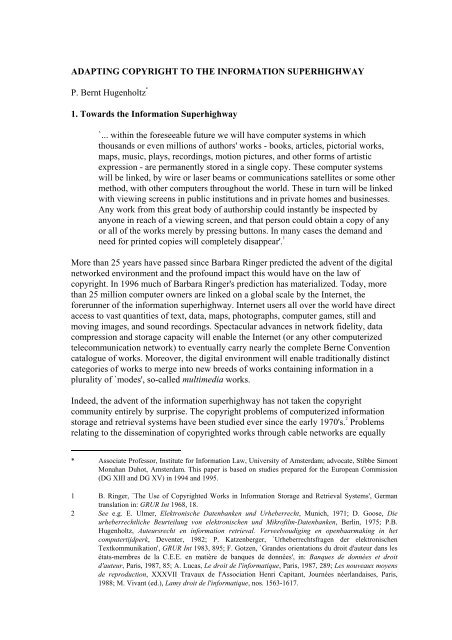
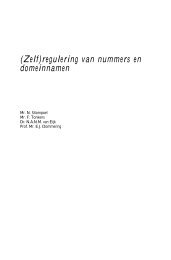
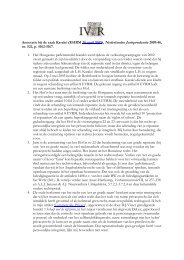

![Legal Opinion of Professor Egbert Dommering [1] concerning ... - IViR](https://img.yumpu.com/23603085/1/184x260/legal-opinion-of-professor-egbert-dommering-1-concerning-ivir.jpg?quality=85)
